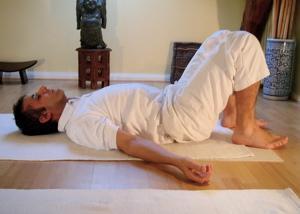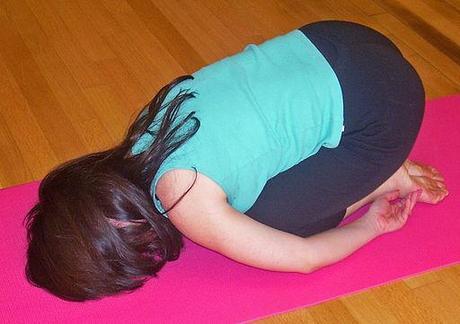It’s actually really fun, in ways that hard physical work can sometimes be really fun. Additionally, because it’s a practice I used for my students, it’s one where I tried to make different options for different bodily needs. In class, this worked out so that most people could select a place that was the right level of work for them; I’m hoping this holds relatively true for larger sample sizes.
A quick note: In places where it lists “options,” I tend to do one of two things. When I’m going through the sequence with a group, I start with what I think of as the physically “easiest” version of a movement, then move on to variations that require more strength or balance or whatever. When there are people who are figuring out which option is right for them, this tends to let them experiment while having a “safety net” — in other words, a version of the pose that they know they can do — to come back to. However, if I’m practicing on my own, I might do all the repetitions with the same asana variation — since I’m already more likely to know what’s going to work for me on a given day. (Not always, but more often than someone experimenting with these poses for the first or second time.)
Centering & Warm Up:
- Start out in constructive rest. Because it’s a core-focused practice, I like to start with one or both hands on the belly, drawing attention to the abdominal movement during breath. In class, I tend to stay here for several breaths; alone, I might stay as long, or I might cut it shorter.
- Then a reclined warm up flow that starts out in constructive rest. Inhale into apanasana (knees to chest) and exhale back down into constructive rest; then inhale into bridge and exhale back down into constructive rest. I repeat the whole sequence for a total of 5 complete rounds, but 5 is not necessarily everybody’s magic number.
- Fart pose! Because fart pose, that’s why. Again, about 5 rounds of this; I do like to keep the number consistent with however many rounds I did in the constructive rest flow.
- Then a held bridge — maybe with a deeper backbend than the rolling variety, maybe not — for 5 breaths. I might spend a final breath in constructive rest and/or with knees to chest before coming to stand.

Sun Salute A:
- Three — or so — rounds of Sun Salute A, taking any standard modifications that seem like a good idea.
- Finally, we did one modified sun salute — stepping back from ardha uttanasana directly to down dog — to come to hands and knees for some plank variations.
Plank Variations:
And other prone core work.
- First, 5 modified chaturanga pushups. For folks for whom this is the wrong kind of difficult, modifications include bringing the knees forward some (closer to directly under the hips) and/or not lowering all the way into chaturanga. Another option includes doing fewer than 5 repetitions.
- After that, lower all the way to the floor and rest for a few breaths, turning the head to one side.
- Either 5 (or, you know, whichever other number you’re going with) rounds of locust or cobra in a vinyasa — inhale up into the backbend, then exhale to lower.
- Then another few breaths on the floor, turning the head to the opposite side.
This is where that “options” idea starts to come into play. This is the sequence I use in class — letting students decide for themselves which option is the right amount of work — but it totally works to just pick any of the options and repeat multiple times.
- Something I like to call “traveling bird dog.” Basically, it starts on hands and knees. On one exhale, lift the left leg; lower on the inhale. On the next exhale, lift the right leg; lower on the inhale. Repeat with the arms (which I find actually trickier in terms of balance). It can be helpful to repeat this a second time to get used to the rhythm, but it’s definitely not necessary.
- Maybe rest in child’s pose, depending on how much physical effort that entailed.
- The next option is a traveling forearm plank. The way I do it, this involves getting into forearm plank. Then exhale, left foot up; inhale it back down. Exhale, right foot up; inhale it back down. Because I find lifting the arms in the pose awkward as well as difficult, I just repeat the sequence with the feet again — so there are still 4 lifts and lowers of some limb or other.
- How about that rest in child’s pose?
- A third option is traveling plank, which is just like traveling bird dog but in plank pose.
- A rest in child’s pose, whether I think I need it or not.
- Because then, if I have it in me, I’m going to repeat whichever variation was my maximum “safe and still beneficial” level one more time.
- Aaaand… child’s pose.

And ack! I had no idea I’d sequenced a practice that would take longer than one reasonably sized blog post to write. I will finish this tomorrow, I promise.
Unless I fall asleep and forget.
Which could happen.

